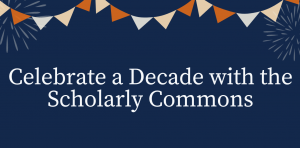This month marks the 10th anniversary of the Scholarly Commons! To celebrate this momentous occasion, the Scholarly Commons is presenting a digital exhibition commemorating our history. This digital exhibition will highlight the projects, partnerships, and people that supported the unit over the past ten years. The exhibition will include:
An Interactive Timeline of the Scholarly Commons History
The Scholarly Commons has celebrated many milestones over the course of the past decade. From creating the Savvy Researcher Workshops to hosting symposiums and competitions to inviting guest scholars to the UIUC campus to share their ideas and projects with our community. The Scholarly Commons has created long-lasting initiatives that enrich the academic life of the UIUC.
To commemorate some of our biggest achievements, the Scholarly Commons has created a timeline featuring the projects, partnerships, and people who have built the Scholarly Commons through the years. To read these highlights and learn about the future of the Scholarly Commons, you can view the timeline here.
A GIS Mapping Project Highlighting Former Scholarly Commons Graduate Assistants
Graduate Assistants play a valuable role in keeping the Scholarly Commons functional and efficient. They provide consultation services for patrons, develop instructional materials for technologies and tools in the Scholarly Commons, facilitate in-person and virtual workshops, and perform a wide variety of other tasks. By the time they graduate and leave the Scholarly Commons, our hope is that our Graduate Assistants gain new technical skills, form long-lasting relationships, and develop a profound sense of professionalism and responsibility that they will carry with them throughout their careers.
To recognize the achievements of our former GAs, the Scholarly Commons has created an interactive map showcasing where they are now and how their time with the Scholarly Commons impacted their careers. To see the global influence of the Scholarly Commons for yourself, you can view the map here.
A Talk by Guest Speaker Thomas Padilla
On Tuesday October 20, 2020 from 3:30-4:30pm, former Scholarly Commons Graduate Assistant and current Interim Head of Knowledge Production at the University of Nevada Las Vegas Libraries Thomas Padilla will lead a discussion around the importance of responsible operations in libraries.
Drawing on his experience leading development of the research agenda Responsible Operations: Data Science, Machine Learning, and AI in Libraries, Padilla will discuss how cultural heritage practitioners and their partners can improve collection description and discovery, develop machine actionable collections, and create space for members of their organizations to expand skills and deepen cross-functional community partnerships using data science, machine learning, and AI technology. To attend this lecture, use this Zoom Webinar Link.
To stay updated on all these events and more, please visit our 10th anniversary webpage on the Scholarly Commons website. Thank you all for celebrating 10 years with us!



